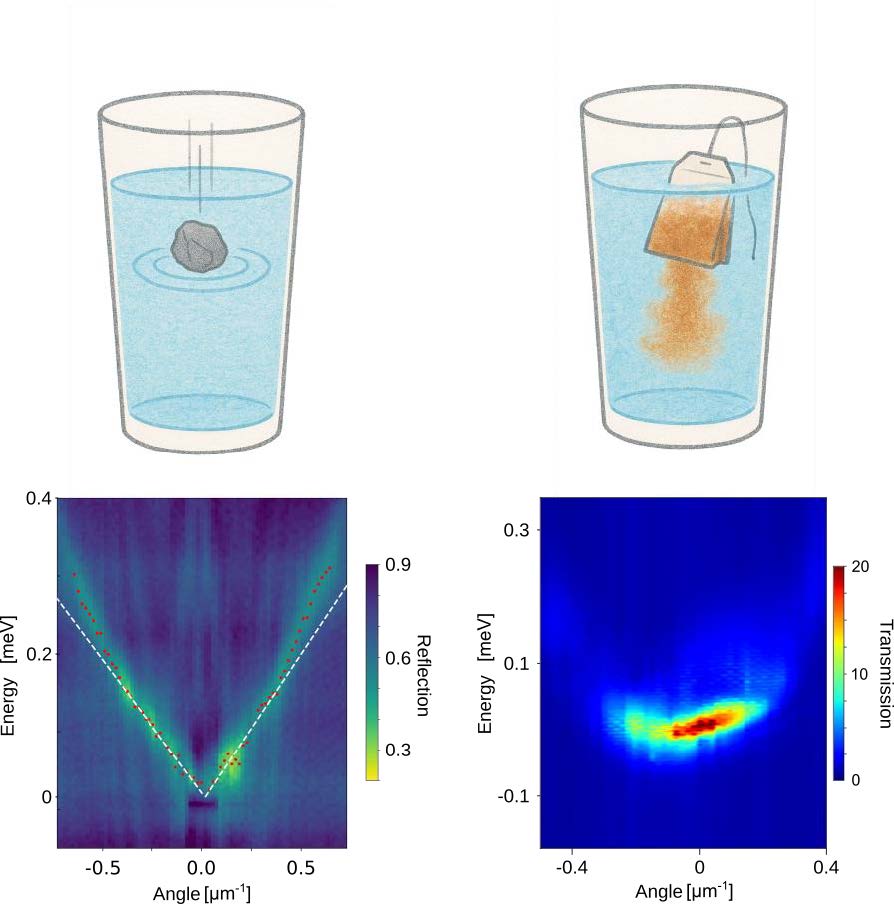- Home
- Laboratory
- Presentation
- News
- Phase transitions: a wave that doesn’t propagate but spreads like tea in water
Phase transitions: a wave that doesn’t propagate but spreads like tea in water
A new quantum phenomenon: a Nambu Goldstone mode that does not propagate, but rather diffuses.

Imagine two simple scenarios: in one, you strike the water in your bathtub a wave spreads in circles. In the other, you steep a teabag the colour slowly diffuses without creating ripples. These two very different dynamics have now been demonstrated at the quantum scale by researchers at lkb. They observed a phenomenon related to phase transitions the moment when a system changes state, such as water freezing or boiling. In equilibrium systems, these transitions are often accompanied by the emergence of waves known as Nambu Goldstone modes, which propagate like waves in water. But in non equilibrium systems, these same modes no longer propagate. They diffuse like tea in hot water.
Equilibrium or non equilibrium: a world of difference
Physics textbooks often discuss systems in equilibrium — idealised scenarios where energy exchanges are balanced. But in reality, almost everything is out of equilibrium: a campfire, a living cell, a star… or a polariton condensate (quasi-particles that are part light, part matter), such as the one studied in this experiment. These systems require constant energy input to exist.
A polariton condensate was created and probed by researchers at lkb to observe its response to excitation. The result: contrary to classical cases where a wave propagates, here it gradually fades away by diffusing. A clear signature of the diffusive dynamics predicted by theory, but never before observed.
The fragility of spontaneous order
This diffusive dynamic appears when a symmetry is spontaneously broken — a process where order arises without being externally imposed, like a flock of birds choosing a direction without a leader. This lies at the heart of phase transitions.
But the team went further: they deliberately imposed a “conductor” on the system using an additional laser beam. Immediately, the nambu-goldstone mode vanished. As expected, the dynamics changed — an experimental proof of the fragility of this spontaneous order.
A step towards understanding irreversibility
These results open a window onto an entire class of physical phenomena: those that escape the laws of equilibrium, which nonetheless govern most classical and quantum theories. In the long term, this research could inspire new photonic devices or help to better understand complex systems such as living cells or quantum circuits.
References : Claude F., Jacquet M.J. et al., Observation of the diffusive Nambu-Goldstone mode of a non-equilibrium phase transition, Nature Physics, 2025. DOI : 10.1038/s41567-025-02902-z
https://www.nature.com/articles/s41567-025-02902-z
Read also
CNRS Recruitment – Join the LKB
External Recruitment for Researchers (M/F)
Nathan Goldman is among the Highly Cited Researchers
Clarivate list



